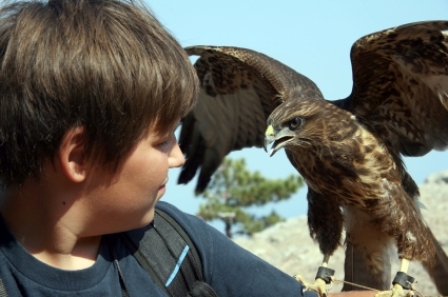Falconry FAQs for beginners
Are you just starting with falconry or are you seriously considering it? Please read further below for some helpful falconry beginner tips.
To introduce you properly to the noble sport of falconry we have also put together a Ben Long Starter Pack for you, you can find it in the shop, with all the top quality items of equipment you will need to train and maintain your new hawk, giving you and you hawk a safe and trouble-free introduction to the sport. We also provide falconry courses with Ben Long, and you can e-mail or phone Ben for free advice on +44 (0)844 879 3238 or +44 (0)7970 038169.
Also please read our blog article about tips for starting with falconry here
Beginner Tips (7)
Most of all, make sure you have the correct housing, food and equipment before your bird arrives. The correct accommodation for a falconry bird is not an aviary, but should be a fully-enclosed “mews” (a modified wooden shed is OK) for initial training and afterwards every night. From the time when the hawk is at least part trained, during the day the bird is “weathered” – tethered to its perch, with a bath within reach, if possible on a lawn, but under a lean-to-shelter (a “weathering shelter”) in case of bad weather or very hot summer sun. No hawks should be left outside in temperatures BELOW FREEZING, or you will risk the hawk having frostbite. This is often in the form of “wing tip oedema”, and the wing tips will be damaged such that the hawk will NEVER fly properly again. The weathering lawn may need to be fenced to keep out dogs or foxes if no-one is around to look after the hawk. Domestic cats are not usually a problem.
Training is a surprisingly short process. A Harris hawk can be trained to fly totally free and retrun to the falconer in about 3 weeks, or even less.
The hawk must be a little hungry when flown, as it ONLY returns to the falconer for food. It is weighed at the beginning of the training, and the falconer will expect to reduce the fat weight of the hawk by about 10% to start with, and will adjust this “flying weight” a little if necessary.
This is a process whereby the hawk is made steady to all the things it has to see when in a captive state. The hawk is firstly expected to take food on the glove, which will require a reduction in weight to make it hungry enough to do this. Afterwards, the hawk can be carried around whilst eating. This can help to take its mind off any scary sights and sounds. To make the meal last longer, we use “tirings”, which are pieces of meat with bones in , which the hawk can only eat slowly. The longer the meal lasts, the more manning the hawk gets every day. If you try to man the hawk without tiring, it will take much longer, and it will never be as steady as one which is manned using tirings. HAWKS KEPT AT THEIR FAT WEIGHT DO NOT MAN, and will NEVER be trained.
REMEMBER: Hawks return to the falconer for food, NOT for affection, and must be a little hungry when flown. Appetite is induced by weight reduction ONLY. It is not possible to start training without weight control.
All birds of prey eat raw meat only. It is common to feed a day-old chicks, but this diet is not sufficient on its own. You should feed a varied diet, including possibly rabbits, quail, rats or mice, along with a vitamin/mineral supplement.
There are differing opinions, but if you intend to go an to take wild quarry, a Harris’ hawk is very user-friendly, robust, and easy to train and handle. You could also consider a redtailed buzzard, although they are slightly harder for a beginner. With any bird that will not generally catch anything its usefulness ends as soon as it is trained, whereas the Harris’ or redtail will go on taking quarry and improving over months or years. AVOID anything small, like a barn owl or kestrel, and there is no margin for error with weight, NEVER think of the hard birds like goshawks, sparrowhawks or eagles until you are very experienced. Some of the middle-sized to larger falcons are relatively easy to train, but will ALWAYS need to be flown with radio-tracking equipment. You may be interested in owls, and some species can be flow successfully, and some will even take quarry. However, if it is your intention to fly at quarry you may be giving yourself a very hard time.
A Harris’ or redtail, trained properly and flown at the correct weight is unlikely to be lost, but they ARE regularly lost by inexperienced falconers, and it is likely most will not survive in the wild. Tracking equipment is NOT a shortcut to training a hawk properly, but is the next best thing to a guarantee that you will get your hawk back if anything unforeseen occurs, and is therefore well worth considering if it can be afforded. A good system is probably going to cost more than the bird, but remember that you keep the system for many years, and it will help to locate lost hawks time and time again. NEVER buy a cheap system. You will not have an effective guarantee if it goes wrong, and they are ALWAYS inferior in operation.

